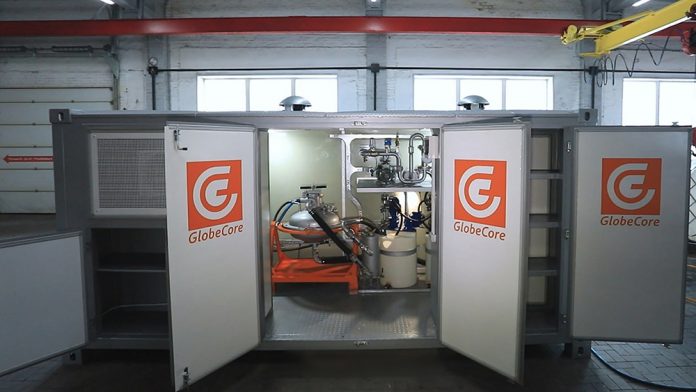New technology using a vortex layer of ferromagnetic particles is a quicker, safer, more cost-effective way to decontaminate wastewater, say Stanislav Mykytenko,
Oleg Kryvokhyzha and Andrii Laptiev, of GlobeCore, Ukraine.
Water pollution is a global problem, and surface water contamination is no exception. Discharge of untreated and insufficiently treated municipal and industrial wastewater can be tackled with environmentally safe, zero-waste technological processes and production facilities, but these are very costly. The most popular solution remains improving the efficiency of wastewater treatment. However, even high-quality treatment methods will still see a considerable number of heavy metals entering – and polluting – the natural environment. The most common heavy metals include chromium, nickel, and copper1, and wastewater contaminated with highly toxic compounds of hexavalent chromium is one of the most hazardous types of effluents.
How hexavalent chromium enters wastewater and its hazards
Chromium-containing wastewater prevalently results from washing of parts after chrome plating, electrochemical polishing, and removal of poor-quality coatings at electroplating facilities2. If the electroplating industry sewage is not efficiently treated, heavy metals enter natural water bodies and the soil, and reach humans through food chains.
Chromium (III), especially chromium (VI) compounds are toxic to humans and animals. Chromium is a carcinogenic substance that causes neoplastic processes, so it is vital to reduce the concentration of chromium in washing effluents as much as possible.
The removal of trivalent and hexavalent chromium compounds is one of the most critical tasks in the field of wastewater treatment.
Existing treatment methods and their disadvantages
The main task of decontaminating wastewater containing chromium (VI) compounds is reduction to the trivalent state. Chromium (III) compounds are much less toxic and prone to hydrolysis in an alkaline medium which allows removing them in the form of hydroxide during further treatment.
There are a great number of methods for extracting heavy metal ions from wastewater, but the following are most prevalently used: chemical-based, biochemical, electrochemical, membrane, sorption, and combined ones3.
At treatment facilities, wastewater containing heavy metals is mainly decontaminated by classic chemical-based methods.
The processes that occur during wastewater treatment by a chemical-based method can be classified into three groups:
1. Reduction-oxidation (redox) processes resulting in formation of non-toxic and low-toxic products (Cr+6 Cr3+);
2. Conversion of impurities into water-insoluble compounds with subsequent removal of precipitate (Cr+6 + 3OH– Cr(OH)3);
3. Neutralisation of acids and bases.
It is also important to adjust the pH value.
The course of the reaction for chromium reduction in an acidic medium depends on the initial concentration of chromium (VI), the pH value, and the temperature. These parameters affect the completeness of reduction and the required excess of reducing agent.
Main difficulties that arise when using the classic method for treating chromium compounds are associated with4:
1) decreasing the hexavalent chromium concentration to the maximum permissible concentrations (MPC) (0.005–0.01 mg/L);
2) high chemical agent and electric power consumption during reduction.
GlobeCore’s experience shows that the disadvantages of using a chemical-based method for treatment of hexavalent chromium-containing wastewater can be eliminated using technology with a vortex layer of ferromagnetic particles1,2,5.
Improving the efficiency of chemical-based treatment using vortex layer technology
A vortex layer device (AVS) is a system consisting of an operating chamber placed in an inductor of a rotating electromagnetic field.
The device’s operating chamber is a pipeline wherein, driven by a rotating electromagnetic field, steel ferromagnetic particles of cylindrical shape move along complex trajectories that constantly contact the substances running through the pipeline and regularly collide with one another and the operating chamber walls.
At the same time, various physical phenomena arise in the operating zone of the device due not only to water and chemical agent mixing, but also a more complete and intensive course of chemical reaction. Constant impact and friction lead to abrasion of ferromagnetic particles and formation of colloidal metal that serve as a good reducing agent.
Meanwhile, hydrogen develops during dispersion due to water electrolysis. Both the first and second factors influence the course of reduction reaction for hexavalent chromium and other heavy metals. In this regard, it takes only a few kilowatts of active power to create a rotating electromagnetic field.
The presence of a vortex layer device makes wastewater treatment complexes more compact due to the mixing that occurs in-stream which no longer requires large mixing tanks; it’s more energy-efficient because there is no requirement for use of mechanical mixers; and it also avoids the use of expensive chemical agents due to the rapid course of chemical reactions.
Practical results of treatment of hexavalent chromium-containing wastewater with the technology
Prior to treatment, we took samples of electroplating workshop wastewater. In the samples taken, the concentration of hexavalent chromium made 364 mg/L which is almost 7,300 times higher than the maximum permissible concentration of 0.05 mg/L. AVSk-150 complex equipped with a ferromagnetic particles vortex layer device was used for treatment.
The general technique
Wastewater may come from different workshops and contain chromium of different concentrations. In this case, it is difficult to calculate the amount of chemical agen correctly. Therefore, during the work shift, all the effluents are collected into a separate balancing tank where the concentration is equalised.
After filling the balancing tank, a float mechanism is triggered and generates a signal to start operating on the control panel of the device. After the signal is received, the vacuum pump starts running and powers up the pipeline. Upon powering up the pipeline, the main supply pump starts running; the water enters the mixing chamber whereinto a chemical agent solution, i.e. iron sulfate, is fed by a dosing pump.
After pre-mixing, the water and the chemical agent enter the operating chamber of the vortex layer device where hexavalent chromium is converted to trivalent chromium after which it enters the storage tank.
At the second stage, the water is pre-mixed with a chemical agent, i.e. lime milk, and enters the operating chamber of the vortex layer device again where a chemical reaction for converting trivalent chromium to poorly soluble compounds ends. Afterwards, the water enters the tank, settles down, and becomes separated into liquid (treated water) and solid (precipitate) fractions.
Upon completion of treatment, we analysed the treated water and obtained the following results:
- hexavalent chromium – not contained;
- total chromium concentration – 0.05 mg/L;
- pH = 8.
The result? Hexavalent chromium content after treatment does not exceed the maximum permissible concentration.
Conclusions
These results prove the high-level treatment of electroplating industry wastewater containing hexavalent chromium through the use of electromagnetic devices with a vortex layer of ferromagnetic particles. In a vortex layer, processing lasts for a few seconds versus 15–30 minutes when using mechanical mixers, and the amount of in-use chemical agents can be cut back 1.5–2 times.
There are also significant savings in electricity useage – 0.3 kWh per 1 m3 of wastewater compared to 0.6–0.8 kWh when using mechanical mixers.
Treated water can be used in recycling water supply systems for industry, and discharged into fisheries or sewers. More information at globecore.com.
References
1. F. May, Electromagnetic intensification of heavy metal removal and wastewater decontamination, Water Today, August, 2017, pp. 32-38.
2. F. May, Improving efficiency of electroplating wastewater treatment, Water Technology, March/April, 2018, pp. 22-25.
3. D. Logvinenko, O. Shelyakov, Intensification of technological processes in devices with a vortex layer, Tehnika, 1976, P. 144 (in Russian)
4. V. Oberemok, M. Nikitenko, Electromagnetic devices with ferromagnetic working elements. Intensification of technological processes in the treatment of industrial wastewater, PUET, 2012, P. 318 (in Ukrainian)
5. O. Mazur, Improving wastewater treatment at electroplating facilities, Water & Wastewater Asia, September/October, 2023, pp. 43-44.




